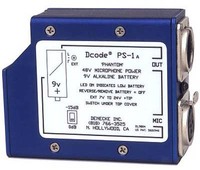RF or true condenser microphones are the mainstay of the professional industry. They go beyond the electro-magnetic capacitor design of the electrets, instead employing sophisticated discriminator-tuned circuits. Suffice to say that RF condensers are capable of greater sensitivity and sound quality than their counterpart electrets, but condensers are physically more fragile. If we think of electret condenser mics as electric typewriters, then the condenser microphones are word processors.
A good example of condenser microphones include the Sennheiser "shotgun" mics which are so much a part of this industry -- namely, the MKH 416 and MKH 60; and the ever popular Audio Technica BP4073.
Condenser microphones require a stronger voltage in order to operate. This is usually either 12 or 48 volts, depending on model. Microphones intended for use in (music) recording studios commonly draw 48 volts, whereas mics intended for film and television originally used 12 volts.
There are four different designs of remote microphone powering. These are: 48v phantom; 12v phantom; (normal) 12v T powering (also referred to as 12v A-B powering);and the variant (polarity reversed) 12v T powering (also referred to as red dot or Nagra-style T powering).
The difference between phantom and T-powering is the route by which the powering voltage is transmitted to the microphone through the cable.
In T-powering (aka A-B powering), the 12 volts are sent to the condenser microphone through the standard three-pin XLR mic cable, employing pin 2 as positive and pin 3 as negative. Pin 1 is ignored.
In phantom powering, which exists in both a 12v as well as a 48v version, pin 1 is negative while (both) pins 2 and 3 are positive.
Condenser microphones do not contain their own power supply -- some sort of external powering must be employed. In studios, this may consist of either a 48v phantom power supply (running off of AC), or a provision in the mixing console to supply the condenser powering. For field work, the microphone powering can emanate from a battery supply, from some mixing panels, or from some recorders & camcorders.
 A few major audio companies (such as Denecke Inc and PSC) manufacture and market convenient battery power supplies. Normally, there are configured for 48v Phantom powering although some models for the less common 12v T powering are available. Measuring close to the size of a cigarette pack, these units work off of one or two 9v batteries and may contain built-in pads and low-cut filters. These units are employed between the condenser microphone and the mic level input. The output from these units going to the recorder is considered by the recorder as the same as if coming from dynamic microphones. In other words, no special pre-amps able to supply (and filter) mic powering are required by the host recorder.
A few major audio companies (such as Denecke Inc and PSC) manufacture and market convenient battery power supplies. Normally, there are configured for 48v Phantom powering although some models for the less common 12v T powering are available. Measuring close to the size of a cigarette pack, these units work off of one or two 9v batteries and may contain built-in pads and low-cut filters. These units are employed between the condenser microphone and the mic level input. The output from these units going to the recorder is considered by the recorder as the same as if coming from dynamic microphones. In other words, no special pre-amps able to supply (and filter) mic powering are required by the host recorder.
Denecke PS1-A Phantom Power Supply
In lieu of using a battery power supply, most production mixing panels have the capability of providing phantom powering directly. Make certain that the panel is designating the type of powering that the mic requires. Phantom is not the same as T-powering (A-B powering). Although there are a few mixing boards that still offer a selectable choice of T power or Phantom, the vast majority of mixers these days are set up for Phantom power only. However, PSC does make an adapter that converts Phantom power to T power.
 Some background information about the two forms of T power and their motion picture origins. Early condenser shotgun microphones were designed to be powered directly out of a Nagra -- providing that the proper pre-amps have been installed in the recorder. Nagras use two microphone pre-amp modules (one each for Mic Input 1 and Mic Input 2), which are selected from the following choices: QPSE-200-XOYO QPM3-5, or QPAU-T/QPU-T.
Some background information about the two forms of T power and their motion picture origins. Early condenser shotgun microphones were designed to be powered directly out of a Nagra -- providing that the proper pre-amps have been installed in the recorder. Nagras use two microphone pre-amp modules (one each for Mic Input 1 and Mic Input 2), which are selected from the following choices: QPSE-200-XOYO QPM3-5, or QPAU-T/QPU-T.
The "regular" pre-amps (QPSE.200-XOYO) are made for standard low-impedance dynamic microphones. These pre-amps will also work with (self-powered) electret condenser mics, or with condenser microphones if they are (self) powered from an external battery power supply.
The QPM 3-5 pre-amp is strictly designed for T-powered condensers, such as the Sennheiser MKH416T, MKH816T. It will provide the necessary DC voltage. However, because T power sends voltage up the same wires as the microphone sends audio down, there is a large potential for electrical interference (cancellation of audio). What that means in the real world is that you can only use mics designated as T power with the presence of T powering. Otherwise, you will end up with little or no audio!
